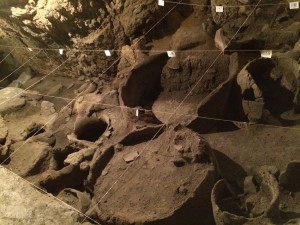
As caves go it’s not the sort to attract attention: no souvenir shops on the approach and no dramatic lighting within. What can be seen from the outside is a narrow vertical opening in a sheer rock face located deep in Armenia’s mountainous southeast. But, in 2011, it was found to conceal treasures. Among them, the world’s oldest known shoe; the world’s oldest known human brain tissue; the world’s oldest known winery. I visited the site in 2015 and what I learned from the archaeologist who headed the team excavating it has colored my thinking about wine ever since.
The cave and its remarkable contents indicate that it was in use as early as 6000 BCE. In this period, once-mobile bands of hunter-gatherers had begun to settle down to practice a kind of proto-farming, made possible in part by the development of ceramic technology. Waterproof fired pottery vessels meant grain could be safely stored from one harvest to the next and seed-stock preserved – but also that fruit fermentations could be controlled and stored with later consumption in mind.
There’s plenty of material online about the cave and its contents, so I won’t go over that ground here. In its eagerness to make the story relevant for the average reader most press coverage of the site overlooked what is surely the most interesting aspect of the find: The origins of wine have no connection to gastronomy.
As our guide, Dr. Boris Gasparyan, explained to our rather horrified tour group, the so-called winery wasn’t really a production facility, but a site for the performance of fertility rituals aimed at ensuring that the cycle of the seasons would be repeated for another year. Analysis of the pottery vats (above) reveal that children were sacrificed here, their blood added to the pots of fermenting juice, which was then consumed by the community – or perhaps just elite segments of it. Long, hollow reeds found at the bottom of several vats indicate that the new wine may have been sipped with straws, perhaps while it was still alive with carbon dioxide. Sparkling wine, it seems, did not have to wait for Dom Perignon.
Dr. Gasparyan believes that some of wine’s original, neolithic meanings survive in modern religious practice. In the ritual of the Mass, he noted, blood and wine are both closely related and magically interchanged. As for the unfortunate children, it appears that they were prepared for their ceremonial deaths by being fed a special diet – an element with echoes in European fairy tale narratives.
There’s more to be discovered in the cave, but according to an international convention, 30% of the site must be left unexplored. The idea is that since the technology for conducting these excavations is advancing at a rapid rate, it’s wise to leave something for future generations of scientists to apply themselves to . . . and be horrified by.